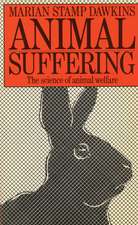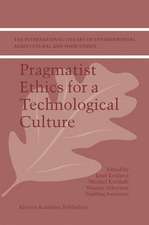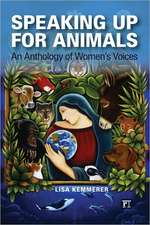Animal Ethics in the Age of Humans: Blurring boundaries in human-animal relationships: The International Library of Environmental, Agricultural and Food Ethics, cartea 23
Editat de Bernice Bovenkerk, Jozef Keulartzen Limba Engleză Paperback – 22 apr 2018
| Toate formatele și edițiile | Preț | Express |
|---|---|---|
| Paperback (1) | 647.08 lei 6-8 săpt. | |
| Springer International Publishing – 22 apr 2018 | 647.08 lei 6-8 săpt. | |
| Hardback (1) | 902.69 lei 6-8 săpt. | |
| Springer International Publishing – 3 oct 2016 | 902.69 lei 6-8 săpt. |
Din seria The International Library of Environmental, Agricultural and Food Ethics
- 15%
 Preț: 707.96 lei
Preț: 707.96 lei -
 Preț: 451.76 lei
Preț: 451.76 lei - 18%
 Preț: 731.10 lei
Preț: 731.10 lei - 18%
 Preț: 744.53 lei
Preț: 744.53 lei - 18%
 Preț: 899.87 lei
Preț: 899.87 lei - 18%
 Preț: 1831.27 lei
Preț: 1831.27 lei - 15%
 Preț: 644.82 lei
Preț: 644.82 lei - 15%
 Preț: 643.16 lei
Preț: 643.16 lei - 18%
 Preț: 947.04 lei
Preț: 947.04 lei - 18%
 Preț: 953.20 lei
Preț: 953.20 lei - 15%
 Preț: 646.62 lei
Preț: 646.62 lei - 15%
 Preț: 646.75 lei
Preț: 646.75 lei - 18%
 Preț: 1116.40 lei
Preț: 1116.40 lei - 15%
 Preț: 643.99 lei
Preț: 643.99 lei - 18%
 Preț: 953.65 lei
Preț: 953.65 lei - 15%
 Preț: 645.28 lei
Preț: 645.28 lei - 15%
 Preț: 637.28 lei
Preț: 637.28 lei - 18%
 Preț: 786.66 lei
Preț: 786.66 lei - 15%
 Preț: 644.30 lei
Preț: 644.30 lei -
 Preț: 398.74 lei
Preț: 398.74 lei - 18%
 Preț: 902.69 lei
Preț: 902.69 lei - 24%
 Preț: 697.63 lei
Preț: 697.63 lei -
 Preț: 388.52 lei
Preț: 388.52 lei - 20%
 Preț: 570.97 lei
Preț: 570.97 lei - 18%
 Preț: 784.61 lei
Preț: 784.61 lei - 15%
 Preț: 527.79 lei
Preț: 527.79 lei - 24%
 Preț: 635.50 lei
Preț: 635.50 lei - 15%
 Preț: 647.08 lei
Preț: 647.08 lei
Preț: 647.08 lei
Preț vechi: 761.27 lei
-15% Nou
Puncte Express: 971
Preț estimativ în valută:
123.82€ • 129.60$ • 103.06£
123.82€ • 129.60$ • 103.06£
Carte tipărită la comandă
Livrare economică 01-15 aprilie
Preluare comenzi: 021 569.72.76
Specificații
ISBN-13: 9783319830100
ISBN-10: 3319830104
Ilustrații: XVII, 414 p. 5 illus.
Dimensiuni: 155 x 235 mm
Greutate: 0.6 kg
Ediția:Softcover reprint of the original 1st ed. 2016
Editura: Springer International Publishing
Colecția Springer
Seria The International Library of Environmental, Agricultural and Food Ethics
Locul publicării:Cham, Switzerland
ISBN-10: 3319830104
Ilustrații: XVII, 414 p. 5 illus.
Dimensiuni: 155 x 235 mm
Greutate: 0.6 kg
Ediția:Softcover reprint of the original 1st ed. 2016
Editura: Springer International Publishing
Colecția Springer
Seria The International Library of Environmental, Agricultural and Food Ethics
Locul publicării:Cham, Switzerland
Cuprins
Introduction.- Jozef Keulartz & Bernice Bovenkerk; Changing relationships with non-human animals in the Anthropocene.- Part 1. Between human and animal.- 1. Anita Guerrini; Deep history, evolutionary history, and animals in the Anthropocene.- 2. Sanne van der Hout; Organisms as teachers? The promise of biomimicry.- 3. Eva Meijer; Interspecies democracies.- 4. Michiel Korthals; Human-animal interfaces from a pragmatist perspective.- 5. Simon Burton & Emily Brady; What is it like to be a bird? Epistemic Humility and Human-Animal Relations.- 6. Jeffrey Moussaieff Masson and Susan McCarthy: Unfeeling Brutes.- 7. Comments: Henk van den Belt; Between human and animal.- Part 2. Between wild and domestic.- 8. Clare Palmer; Climate change, ethics, and the wildness of wild animals.- 9. Bernice Bovenkerk; Animal captivity: justifications for animal Captivity in the context of domestication.- 10. Jac. A.A. Swart; care for the wild in the Anthropocene.- 11. Martin Drenthen; The wolf andthe animal lover.-12. Susan Boonman; Blurred boundaries in wildlife management practices.- 13. Comments: Sue Donaldson & Will Kymlicka; Between wildness and domestication: Rethinking categories and boundaries in response to animal agency.- Part 3. Between freedom and captivity.- 14. Jozef Keulartz; Towards an animal ethics for the Anthropocene.- 15. Aaron Simmons; Animals, freedom, and the ethics of veganism.- 16. T.J. Kasperbauer; Should captive primates have reproductive rights?.- 17. Sabrina Brando; Wild animals in entertainment.- 18. Comments: Clemens Driessen.- Part 4. Between animal ethics and conservation ethics.- 19. Jozef Keulartz; Captivity for conservation? Zoos at a Crossroads (reprint).- 20. Brendon Larson & Stephanie Barr; The flights of the monarch butterfly: Between in situ and ex situ conservation.- 21. Bernice Bovenkerk & Marcel Verwey; Blurring the Boundaries Between Individualistic Animal Ethics and Holistic Environmental Ethics.- 22. Daniel Ramp & Marc Bekoff; Compassion as a practical and evolved ethic for conservation (reprint).- 23. Comments: Hub Zwart; We all live in a planetary Ark (planetary Ark, planetary Ark….).
Recenzii
The first book to systematically address the far-reaching changes in human-animal relationships during the Anthropocene
Contains contributions from researchers at the cutting edge of their fields who systematically examine the broad field of human-animal relations
Focuses on rethinking the traditional divisions between humans and animals
Notă biografică
Dr. Bernice Bovenkerk is assistant professor at the Philosophy Group at Wageningen University. Previously she was post-doc and lecturer at the Ethics Institute at Utrecht University. She received her PhD from the University of Melbourne, Australia, on a dissertation titled The Biotechnology Debate. Democracy in the face of intractable disagreement (which she published with Springer). She received her Master’s title at the University of Amsterdam on a thesis titled Pluralism in Environmental Ethics. Bernice Bovenkerk is currently working on an Innovative Research Grant about the ethics of animal domestication. She has recently carried out research about the moral status and welfare of fish. Her research interests concern issues in animal and environmental ethics and political philosophy. Current topics are the moral status of animals and other natural entities, climate ethics, and deliberative democracy.
Jozef Keulartz is emeritus Professor of Environmental Philosophy at the Radboud University Nijmegen, and senior researcher Applied Philosophy at Wageningen University and Research Centre. He has published extensively in different areas of science and technology studies, social and political philosophy, bioethics, environmental ethics and nature policy. His books include Die verkehrte Welt des Jürgen Habermas [The Topsy-Turvy World of Jürgen Habermas, 1995], Van bestraffing naar behandeling [From Punishment to Treatment, 1996, 4rd ed], Struggle for Nature – A Critique of Radical Ecology (1998), and Werken aan de grens – een pragmatische visie op natuur en milieu [Boundary-Work: A Pragmatist View on Nature and Environment, 2005]. He is editor of Wilhelm Dilthey: Kritiek van de historische rede [Wilhelm Dilthey: Critique of Historical Reason, 1994] and co-editor of Foucault herdenken [In Memory of Foucault, 1995], Museum Aarde [Museum Earth, 1997], Pragmatist Ethics for a Technological Culture (Kluwer, 2002), Legitimacy in European Nature Conservation Policy (Springer, 2008), New Visions of Nature (Springer, 2009), Environmental Aesthetics. Crossing Divides and Breaking Ground (Fordham University Press, 2013), and Old World and New World Perspectives in Environmental Philosophy (Springer, 2014).
Jozef Keulartz is emeritus Professor of Environmental Philosophy at the Radboud University Nijmegen, and senior researcher Applied Philosophy at Wageningen University and Research Centre. He has published extensively in different areas of science and technology studies, social and political philosophy, bioethics, environmental ethics and nature policy. His books include Die verkehrte Welt des Jürgen Habermas [The Topsy-Turvy World of Jürgen Habermas, 1995], Van bestraffing naar behandeling [From Punishment to Treatment, 1996, 4rd ed], Struggle for Nature – A Critique of Radical Ecology (1998), and Werken aan de grens – een pragmatische visie op natuur en milieu [Boundary-Work: A Pragmatist View on Nature and Environment, 2005]. He is editor of Wilhelm Dilthey: Kritiek van de historische rede [Wilhelm Dilthey: Critique of Historical Reason, 1994] and co-editor of Foucault herdenken [In Memory of Foucault, 1995], Museum Aarde [Museum Earth, 1997], Pragmatist Ethics for a Technological Culture (Kluwer, 2002), Legitimacy in European Nature Conservation Policy (Springer, 2008), New Visions of Nature (Springer, 2009), Environmental Aesthetics. Crossing Divides and Breaking Ground (Fordham University Press, 2013), and Old World and New World Perspectives in Environmental Philosophy (Springer, 2014).
Textul de pe ultima copertă
This book provides reflection on the increasingly blurry boundaries that characterize the human-animal relationship. In the Anthropocene humans and animals have come closer together and this asks for rethinking old divisions. Firstly, new scientific insights and technological advances lead to a blurring of the boundaries between animals and humans. Secondly, our increasing influence on nature leads to a rethinking of the old distinction between individual animal ethics and collectivist environmental ethics. Thirdly, ongoing urbanization and destruction of animal habitats leads to a blurring between the categories of wild and domesticated animals. Finally, globalization and global climate change have led to the fragmentation of natural habitats, blurring the old distinction between in situ and ex situ conservation. In this book, researchers at the cutting edge of their fields systematically examine the broad field of human-animal relations, dealing with wild, liminal, and domestic animals, with conservation, and zoos, and with technologies such as biomimicry. This book is timely in that it explores the new directions in which our thinking about the human-animal relationship are developing. While the target audience primarily consists of animal studies scholars, coming from a wide range of disciplines including philosophy, sociology, psychology, ethology, literature, and film studies, many of the topics that are discussed have relevance beyond a purely theoretical one; as such the book also aims to inspire for example biologists, conservationists, and zoo keepers to reflect on their relationship with animals.
Caracteristici
This is the first book to systematically address the far-reaching changes in human-animal relationships during the Anthropocene. Addresses human-animal relationships specifically from an ethics perspective. Explores blurring boundaries between humans and animals, between wild and domesticated animals, in situ and ex situ conservation, and between individualistic animal ethics and holistic environmental ethics. Includes supplementary material: sn.pub/extras















